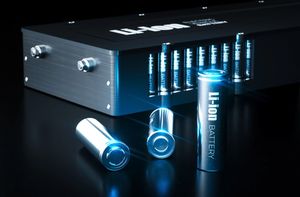
Advanced Micro Devices (NASDAQ: AMD) is rapidly solidifying its position as a major force in the artificial intelligence (AI) sector, driven by a series of strategic partnerships, groundbreaking chip designs, and a robust commitment to an open software ecosystem. The company's recent performance, highlighted by a record $9.2 billion in revenue for Q3 2025, underscores a significant year-over-year increase of 36%, with its data center and client segments leading the charge. This formidable growth, fueled by an expanding portfolio of AI accelerators, is not merely incremental but represents a fundamental reshaping of a competitive landscape long dominated by a single player.
AMD's strategic maneuvers are making waves across the tech industry, positioning the company as a formidable challenger in the high-stakes AI compute race. With analysts projecting substantial revenue increases from AI chip sales, potentially reaching tens of billions annually from its Instinct GPU business by 2027, the immediate significance of AMD's advancements cannot be overstated. Its innovative MI300 series, coupled with the increasingly mature ROCm software platform, is enabling a broader range of companies to access high-performance AI compute, fostering a more diversified and dynamic ecosystem for the development and deployment of next-generation AI models.
Engineering the Future of AI: AMD's Instinct Accelerators and the ROCm Ecosystem
At the heart of AMD's (NASDAQ: AMD) AI resurgence lies its formidable lineup of Instinct MI series accelerators, meticulously engineered to tackle the most demanding generative AI and high-performance computing (HPC) workloads. The MI300 series, launched in December 2023, spearheaded this charge, built on the advanced CDNA 3 architecture and leveraging sophisticated 3.5D packaging. The flagship MI300X, a GPU-centric powerhouse, boasts an impressive 192 GB of HBM3 memory with a staggering 5.3 TB/s bandwidth. This exceptional memory capacity and throughput enable it to natively run colossal AI models such as Falcon-40B and LLaMA2-70B on a single chip, a critical advantage over competitors like Nvidia's (NASDAQ: NVDA) H100, especially in memory-bound inference tasks.
Complementing the MI300X, the MI300A introduces a groundbreaking Accelerated Processing Unit (APU) design, integrating 24 Zen 4 CPU cores with CDNA 3 GPU compute units onto a single package, unified by 128 GB of HBM3 memory. This innovative architecture eliminates traditional CPU-GPU interface bottlenecks and data transfer overhead, providing a single shared address space. The MI300A is particularly well-suited for converging HPC and AI workloads, offering significant power efficiency and a lower total cost of ownership compared to traditional discrete CPU/GPU setups. The immediate success of the MI300 series is evident, with AMD CEO Lisa Su announcing in Q2 2024 that Instinct MI300 GPUs exceeded $1 billion in quarterly revenue for the first time, making up over a third of AMD’s data center revenue, largely driven by hyperscalers like Microsoft (NASDAQ: MSFT).
Building on this momentum, AMD unveiled the Instinct MI325X accelerator, which became available in Q4 2024. This iteration further pushes the boundaries of memory, featuring 256 GB of HBM3E memory and a peak bandwidth of 6 TB/s. The MI325X, still based on the CDNA 3 architecture, is designed to handle even larger models and datasets more efficiently, positioning it as a direct competitor to Nvidia's H200 in demanding generative AI and deep learning workloads. Looking ahead, the MI350 series, powered by the next-generation CDNA 4 architecture and fabricated on an advanced 3nm process, is now available in 2025. This series promises up to a 35x increase in AI inference performance compared to the MI300 series and introduces support for new data types like MXFP4 and MXFP6, further optimizing efficiency and performance. Beyond that, the MI400 series, based on the "CDNA Next" architecture, is slated for 2026, envisioning a fully integrated, rack-scale solution codenamed "Helios" that will combine future EPYC CPUs and next-generation Pensando networking for extreme-scale AI.
Crucial to AMD's strategy is the ROCm (Radeon Open Compute) software platform, an open-source ecosystem designed to provide a robust alternative to Nvidia's proprietary CUDA. ROCm offers a comprehensive stack of drivers, development tools, and APIs, fostering a collaborative community where developers can customize and optimize the platform without vendor lock-in. Its cornerstone, HIP (Heterogeneous-compute Interface for Portability), allows developers to port CUDA applications to AMD GPUs with minimal code changes, effectively bridging the two ecosystems. While CUDA has historically held a lead in ecosystem maturity, ROCm has significantly narrowed the performance gap, now typically performing only 10% to 30% slower than CUDA, a substantial improvement from previous generations. With robust support for major AI frameworks like PyTorch and TensorFlow, and continuous enhancements in open kernel libraries and compiler stacks, ROCm is rapidly becoming a compelling choice for large-scale inference, memory-bound workloads, and cost-sensitive AI training.
Reshaping the AI Arena: Competitive Implications and Strategic Advantages
AMD's (NASDAQ: AMD) aggressive push into the AI chip market is not merely introducing new hardware; it's fundamentally reshaping the competitive landscape, creating both opportunities and challenges for AI companies, tech giants, and startups alike. At the forefront of this disruption are AMD's Instinct MI series accelerators, particularly the MI300X and the recently available MI350 series, which are designed to excel in generative AI and large language model (LLM) workloads. These chips, with their high memory capacities and bandwidth, are providing a powerful and increasingly cost-effective alternative to the established market leader.
Hyperscalers and major tech giants are among the primary beneficiaries of AMD's strategic advancements. Companies like OpenAI, Microsoft (NASDAQ: MSFT), Meta Platforms (NASDAQ: META), and Oracle (NYSE: ORCL) are actively integrating AMD's AI solutions into their infrastructure. Microsoft Azure was an early adopter of MI300X accelerators for its OpenAI services and Copilot, while Meta Platforms employs AMD's EPYC CPUs and Instinct accelerators for its Llama models. A landmark multi-year agreement with OpenAI, involving the deployment of multiple generations of AMD Instinct GPUs starting with the MI450 series, signifies a profound partnership that not only validates AMD's technology but also deepens OpenAI's involvement in optimizing AMD's software stack and future chip designs. This diversification of the AI hardware supply chain is crucial for these giants, reducing their reliance on a single vendor and potentially lowering overall infrastructure costs.
The competitive implications for major players are substantial. Nvidia (NASDAQ: NVDA), the long-standing dominant force, faces its most credible challenge yet. While Nvidia's CUDA ecosystem remains a powerful advantage due to its maturity and widespread developer adoption, AMD's ROCm platform is rapidly closing the gap, offering an open-source alternative that reduces vendor lock-in. The MI300X has demonstrated competitive, and in some benchmarks, superior performance to Nvidia's H100, particularly for inference workloads. Furthermore, the MI350 series aims to surpass Nvidia's B200, indicating AMD's ambition to lead. Nvidia's current supply constraints for its Blackwell chips also make AMD an attractive "Mr. Right Now" alternative for companies eager to scale their AI infrastructure. Intel (NASDAQ: INTC), another key competitor, continues to push its Gaudi 3 chip as an alternative, while AMD's EPYC processors consistently gain ground against Intel's Xeon in the server CPU market.
Beyond the tech giants, AMD's open ecosystem and compelling performance-per-dollar proposition are empowering a new wave of AI companies and startups. Developers seeking flexibility and cost efficiency are increasingly turning to ROCm, finding its open-source nature appealing for customizing and optimizing their AI workloads. This accessibility of high-performance AI compute is poised to disrupt existing products and services by enabling broader AI adoption across various industries and accelerating the development of novel AI-driven applications. AMD's comprehensive portfolio of CPUs, GPUs, and adaptive computing solutions allows customers to optimize workloads across different architectures, scaling AI across the enterprise without extensive code rewrites. This strategic advantage, combined with its strong partnerships and focus on memory-centric architectures, firmly positions AMD as a pivotal player in democratizing and accelerating the evolution of AI technologies.
A Paradigm Shift: AMD's Role in AI Democratization and Sustainable Computing
AMD's (NASDAQ: AMD) strategic advancements in AI extend far beyond mere hardware upgrades; they represent a significant force driving a paradigm shift within the broader AI landscape. The company's innovations are deeply intertwined with critical trends, including the growing emphasis on inference-dominated workloads, the exponential growth of generative AI, and the burgeoning field of edge AI. By offering high-performance, memory-centric solutions like the Instinct MI300X, which can natively run massive AI models on a single chip, AMD is providing scalable and cost-effective deployment options that are crucial for the widespread adoption of AI.
A cornerstone of AMD's wider significance is its profound impact on the democratization of AI. The open-source ROCm platform stands as a vital alternative to proprietary ecosystems, fostering transparency, collaboration, and community-driven innovation. This open approach liberates developers from vendor lock-in, providing greater flexibility and choice in hardware. By enabling technologies such as the MI300X, with its substantial HBM3 memory, to handle complex models like Falcon-40B and LLaMA2-70B on a single GPU, AMD is lowering the financial and technical barriers to entry for advanced AI development. This accessibility, coupled with ROCm's integration with popular frameworks like PyTorch and Hugging Face, empowers a broader spectrum of enterprises and startups to engage with cutting-edge AI, accelerating innovation across the board.
However, AMD's ascent is not without its challenges and concerns. The intense competition from Nvidia (NASDAQ: NVDA), which still holds a dominant market share, remains a significant hurdle. Furthermore, the increasing trend of major tech giants like Microsoft (NASDAQ: MSFT) and Amazon (NASDAQ: AMZN) developing their own custom AI chips could potentially limit AMD's long-term growth in these key accounts. Supply chain constraints, particularly AMD's reliance on TSMC (NYSE: TSM) for advanced manufacturing, pose potential bottlenecks, although the company is actively investing in diversifying its manufacturing footprint. Geopolitical factors, such as U.S. export restrictions on AI chips, also present revenue risks, especially in critical markets like China.
Despite these challenges, AMD's contributions mark several significant milestones in AI history. The company has aggressively pursued energy efficiency, not only surpassing its ambitious "30×25 goal" (a 30x increase in energy efficiency for AI training and HPC nodes from 2020 to 2025) ahead of schedule, but also setting a new "20x by 2030" target for rack-scale energy efficiency. This commitment addresses a critical concern as AI adoption drives exponential increases in data center electricity consumption, setting new industry standards for sustainable AI computing. The maturation of ROCm as a robust open-source alternative to CUDA is a major ecosystem shift, breaking down long-standing vendor lock-in. Moreover, AMD's push for supply chain diversification, both for itself and by providing a strong alternative to Nvidia, enhances resilience against global shocks and fosters a more stable and competitive market for AI hardware, ultimately benefiting the entire AI industry.
The Road Ahead: AMD's Ambitious AI Roadmap and Expert Outlook
AMD's (NASDAQ: AMD) trajectory in the AI sector is marked by an ambitious and clearly defined roadmap, promising a continuous stream of innovations across hardware, software, and integrated solutions. In the near term, the company is solidifying its position with the full-scale deployment of its MI350 series GPUs. Built on the CDNA 4 architecture, these accelerators, which saw customer sampling in March 2025 and volume production ahead of schedule in June 2025, are now widely available. They deliver a significant 4x generational increase in AI compute, boasting 20 petaflops of FP4 and FP6 performance and 288GB of HBM memory per module, making them ideal for generative AI models and large scientific workloads. Initial server and cloud service provider (CSP) deployments, including Oracle Cloud Infrastructure (NYSE: ORCL), began in Q3 2025, with broad availability continuing through the second half of the year. Concurrently, the Ryzen AI Max PRO Series processors, available in 2025, are embedding advanced AI capabilities into laptops and workstations, featuring NPUs capable of up to 50 TOPS. The open-source ROCm 7.0 software platform, introduced at the "Advancing AI 2025" event, continues to evolve, expanding compatibility with leading AI frameworks.
Looking further ahead, AMD's long-term vision extends to groundbreaking next-generation GPUs, CPUs, and fully integrated rack-scale AI solutions. The highly anticipated Instinct MI400 series GPUs are expected to land in early 2026, promising 432GB of HBM4 memory, nearly 19.6 TB/s of memory bandwidth, and up to 40 PetaFLOPS of FP4 throughput. These GPUs will also feature an upgraded fabric link, doubling the speed of the MI350 series, enabling the construction of full-rack clusters without reliance on slower networks. Complementing this, AMD will introduce "Helios" in 2026, a fully integrated AI rack solution combining MI400 GPUs with upcoming EPYC "Venice" CPUs (Zen 6 architecture) and Pensando "Vulcano" NICs, offering a turnkey setup for data centers. Beyond 2026, the EPYC "Verano" CPU (Zen 7 architecture) is planned for 2027, alongside the Instinct MI500X Series GPU, signaling a relentless pursuit of performance and energy efficiency.
These advancements are poised to unlock a vast array of new applications and use cases. In data centers, AMD's solutions will continue to power large-scale AI training and inference for LLMs and generative AI, including sovereign AI factory supercomputers like the Lux AI supercomputer (early 2026) and the future Discovery supercomputer (2028-2029) at Oak Ridge. Edge AI will see expanded applications in medical diagnostics, industrial automation, and autonomous driving, leveraging the Versal AI Edge series for high-performance, low-latency inference. The proliferation of "AI PCs" driven by Ryzen AI processors will enable on-device AI for real-time translation, advanced image processing, and intelligent assistants, enhancing privacy and reducing latency. AMD's focus on an open ecosystem and democratizing access to cutting-edge AI compute aims to foster broader innovation across advanced robotics, smart infrastructure, and everyday devices.
Despite this ambitious roadmap, challenges persist. Intense competition from Nvidia (NASDAQ: NVDA) and Intel (NASDAQ: INTC) necessitates continuous innovation and strategic execution. The maturity and optimization of AMD's software ecosystem, ROCm, while rapidly improving, still require sustained investment to match Nvidia's long-standing CUDA dominance. Converting early adopters into large-scale deployments remains a critical hurdle, as some major customers are still reviewing their AI spending. Geopolitical factors and export restrictions, particularly impacting sales to China, also pose ongoing risks. Nevertheless, experts maintain a positive outlook, projecting substantial revenue growth for AMD's AI GPUs, with some forecasts reaching $13.1 billion in 2027. The landmark OpenAI partnership alone is predicted to generate over $100 billion for AMD by 2027. Experts emphasize AMD's commitment to energy efficiency, local AI solutions, and its open ecosystem as key strategic advantages that will continue to accelerate technological breakthroughs across the industry.
The AI Revolution's New Architect: AMD's Enduring Impact
As of November 7, 2025, Advanced Micro Devices (NASDAQ: AMD) stands at a pivotal juncture in the artificial intelligence revolution, having not only demonstrated robust financial performance but also executed a series of strategic maneuvers that are profoundly reshaping the competitive AI landscape. The company's record $9.2 billion revenue in Q3 2025, a 36% year-over-year surge, underscores the efficacy of its aggressive AI strategy, with the Data Center segment leading the charge.
The key takeaway from AMD's recent performance is the undeniable ascendancy of its Instinct GPUs. The MI350 Series, particularly the MI350X and MI355X, built on the CDNA 4 architecture, are delivering up to a 4x generational increase in AI compute and an astounding 35x leap in inferencing performance over the MI300 series. This, coupled with a relentless product roadmap that includes the MI400 series and the "Helios" rack-scale solutions for 2026, positions AMD as a long-term innovator. Crucially, AMD's unwavering commitment to its open-source ROCm software ecosystem, now in its 7.1 iteration, is fostering a "ROCm everywhere for everyone" strategy, expanding support from data centers to client PCs and creating a unified development environment. This open approach, along with landmark partnerships with OpenAI and Oracle (NYSE: ORCL), signifies a critical validation of AMD's technology and its potential to diversify the AI compute supply chain. Furthermore, AMD's aggressive push into the AI PC market with Ryzen AI APUs and its continued gains in the server CPU market against Intel (NASDAQ: INTC) highlight a comprehensive, full-stack approach to AI.
AMD's current trajectory marks a pivotal moment in AI history. By providing a credible, high-performance, and increasingly powerful alternative to Nvidia's (NASDAQ: NVDA) long-standing dominance, AMD is breaking down the "software moat" of proprietary ecosystems like CUDA. This shift is vital for the broader advancement of AI, fostering greater flexibility, competition, and accelerated innovation. The sheer scale of partnerships, particularly the multi-generational agreement with OpenAI, which anticipates deploying 6 gigawatts of AMD Instinct GPUs and potentially generating over $100 billion by 2027, underscores a transformative validation that could prevent a single-vendor monopoly in AI hardware. AMD's relentless focus on energy efficiency, exemplified by its "20x by 2030" goal for rack-scale efficiency, also sets new industry benchmarks for sustainable AI computing.
The long-term impact of AMD's strategy is poised to be substantial. By offering a compelling blend of high-performance hardware, an evolving open-source software stack, and strategic alliances, AMD is establishing itself as a vertically integrated AI platform provider. Should ROCm continue its rapid maturation and gain broader developer adoption, it could fundamentally democratize access to high-performance AI compute, reducing barriers for smaller players and fostering a more diverse and innovative AI landscape. The company's diversified portfolio across CPUs, GPUs, and custom APUs also provides a strategic advantage and resilience against market fluctuations, suggesting a future AI market that is significantly more competitive and open.
In the coming weeks and months, several key developments will be critical to watch. Investors and analysts will be closely monitoring AMD's Financial Analyst Day on November 11, 2025, for further details on its data center AI growth plans, the momentum of the Instinct MI350 Series GPUs, and insights into the upcoming MI450 Series and Helios rack-scale solutions. Continued releases and adoption of the ROCm ecosystem, along with real-world deployment benchmarks from major cloud and AI service providers for the MI350 Series, will be crucial indicators. The execution of the landmark partnerships with OpenAI and Oracle, as they move towards initial deployments in 2026, will also be closely scrutinized. Finally, observing how Nvidia and Intel respond to AMD's aggressive market share gains and product roadmap, particularly in the data center and AI PC segments, will illuminate the intensifying competitive dynamics of this rapidly evolving industry. AMD's journey in AI is transitioning from a challenger to a formidable force, and the coming period will be critical in demonstrating the tangible results of its strategic investments and partnerships.
This content is intended for informational purposes only and represents analysis of current AI developments.
TokenRing AI delivers enterprise-grade solutions for multi-agent AI workflow orchestration, AI-powered development tools, and seamless remote collaboration platforms.
For more information, visit https://www.tokenring.ai/.







